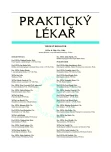Do our patients remember cardiovascular risk factors?
Authors:
E. Sovová 1; J. Leisser 2; J. Ondrušková 1; M. Kaletová 1; I. Benušová 1; P. Doupalová 1
Authors‘ workplace:
Lékařská fakulta Univerzity Palackého a Fakultní nemocnice Olomouc
I. interní klinika
Přednosta: prof. MUDr. Jan Lukl, CSc.
1; Lázně Teplice s. r. o.
2
Published in:
Prakt. Lék. 2010; 90(2): 90-92
Category:
Of different specialties
Overview
Background:
Cardiovascular disease (CVD) is the leading cause of death in the Czech Republic as well as in Europe. Secondary prevention is very important for patient mortality and morbidity. Patients should be informed of the CVD risk factors (RF) (smoking, hypertension, lipid disorders, diabetes, obesity and low physical activity) and the recommended blood pressure levels, blood level of cholesterol, glycaemia, BMI, and exercise heart frequency when undergoing cardiac rehabilitation.
Methods:
169 patients (113 males) aged 62.7±9.1 hospitalized for acute myocardial infarction or coronary angioplasty filled out a questionnaire (knowledge of RF, knowledge of own values of risk factors) upon arrival at a spa for convalescence (average a month after hospitalization). 56 patients (44 males) had taken part in a hospital educational program (EDUC); the rest had only general information about RF (NEDUC). Statistical correlation (chi square, t-test).
Results:
There were no differences between EDUC and NEDUC in gender (p=0.765), age (p=0.798), place of residence (p=0.534), reason for hospitalization (p=0.078), smoking (1.8 % vs. 4.5 %, p=0.677), knowledge of recommended blood pressure values (39.3 % vs. 32.1 %, p=0.392), knowledge of recommended and own blood levels of cholesterol (19.6 % vs. 20.4 %, p= 0.914; 35.7 % vs. 28.6 %, p= 0.345), knowledge of recommended and own blood levels of LDL cholesterol (8.9 % vs. 6.3 %, p= 0.525; 10.7 % vs. 8.8 %, p=0.697), knowledge of own BMI values (16.1 % vs. 8.9 %, p= 0.168), knowledge of the border BMI values for obesity (8.9 % vs. 6.2 %, p=0.515), knowledge of border glycaemia values (37.5 % vs. 24.8 %, p= 0.086) and exercise heart frequency (3.6 % vs. 9.7%, p= 0.224). A significant difference was found in terms of knowledge of the values of their own blood pressure (91.1 % vs. 73.5 %, p= 0.08).
Conclusions:
Knowledge on the part of patients of RF CVD is poor in spite of educational programs. We are in need of a better system for educating patients with the implementation of various educational options and cooperation with patients’ families.
Key words:
cardiovascular risk factors, education, knowledge.
Sources
1. Artinian, N.T. Telehealth as a tool for enhancing care for patiens with cardiovascular disease. J. Cardiovasc. Nurs. 2007, 2(1), p. 25-31.
2. Baberg, H.T., Jager, D., Karhmann, D. et al. Health promotion and cardiovascular risk factors. The level of knowledge among 510 inpatients of an acute coronary care unit. Med. Klin. 2000, 95(2), p. 75-80.
3. Baberg, H.T. Uzun, D. de Zeeuw, J. et al. Health promotion and inpatient rehabilitation. Long-term effects of education in patiens with coronary heart disease. Herz 2005, 30(8), p. 754-760.
4. Bush, R.L., Kallen, M.A., Liles, D.R. et al. Knowledge and awareness of peripheral vascular disease are poor among women at risk for cardiovascular disease. J. Surg. Res. 2008, 145(2), p. 313-319.
5. Celentano, A., Palmieri, V., Areji, E. et al. Cardiovascular secondary prevention: patients´ knowledge of cardiovascular risk factors and their attitude to reduce the risk burden, and the practice of family doctors. The „Help Your Heart Stay Young“ study. Ital. Heart J. 2004, 5(10), p. 767-773.
6. Cuspidi. C. Sampieri, L. Macca,G. et al. Short and long term impal of structured educational program on the patients´ knowledge of hypertension. Ital. Heart J. 2000, 1(12), p. 839-843.
7. Davis, S., Abidi, S.S., Cox, J. Personalised cardiovascular risk management linking SCORE and behaviour chase to Web-based education. Stud. Health Technol. Inform. 2006, 124, p. 235-240.
8. Hrubá, D., Soška, V., Fiala, J. a kol. Kouření a kardiovaskulární nemoci. Prakt. Lék. 2009, 89(2), s. 70-75.
9. Cheng, S., Lichtman, J.H., Amatruda, J.M. et al. Knowledge of cholesterol levels and targets in patiens with coronary artery disease. Prev. Cardiol. 2005, 8(1), p. 11-17.
10. Kaplan, R.C., Bhalodkar, N.C., Brown, D.L. et al. Differences by age and race/etnicity in knowledge about hypercholesterolemia. Cardiol. Rev. 2006, 14(1), p. 1-6.
11. Karel, I., Skalická, H. Kardiorehabilitace, účinná, ale opomíjená léčba. Prakt. Lék. 2008, 88(2), s. 684-688.
12. Kawahara, T., Takahaski, K., Tetsuya, I. et al. Reduced progression to type 2 diabetes from impaired glucose tolerance after a 2-day in-hospital diabetes educational program. Diabetes Care 2008, 31, p. 1949-1954.
13. Migliaresi, P., Celentano, A., Palmieri, V. et al. Knowledge of cardiovascular risk factors and awareness of non-pharmacological approach for risk prevention in young survivors of acute myocardial infarction. The cardiovascular risk prevention project “Help Your Heart Stay Young”. Nutr. Metab. Cardiovasc. Dis. 2007, 17(6), p. 468-472.
14. Mochari, H., Ferris, A., Adigopula, S. et al. Cardiovascular disease knowledge, medication adherence, and barriers to preventive action in a minority population. Prev. Cardiol., 2007, 10(4), p.190-195.
15. Naudziunas, A., Jankauskiene, L., Kalinauskiene, E. et al. Implementation of the patient education about cardiovascular risk factors into a daily routine of the Cardiology Unit of the hospital. Prev. Med. 2005, 41(2), p. 570-574.
16. Oliveria, S.A., Chen, R.S., McCarthy, B.D. et al. Hypertension knowledge, awareness, and attitudes in a hypertensive population. J. Gen. Intern. Med. 2005, 20(3), p. 219-225.
17. Pearce, K.A., Love, M.M., Melton, B.J. et al. Cardiovascular risk education and social support (CaRESS): report of a randomized controlled trial from the Kentucky Ambulatory Network (KAN). J. Am. Board. Fam. Med. 2008, 21(4), p. 269-281.
Labels
General practitioner for children and adolescents General practitioner for adultsArticle was published in
General Practitioner

2010 Issue 2
Most read in this issue
- Tracheal stenosis, diagnosis and treatment options
- Radicular syndrome in the general practitioner’s surgery
- Differential diagnosis of oedema
- Substance abuse preventinon and approaches to managing of cure dependence
